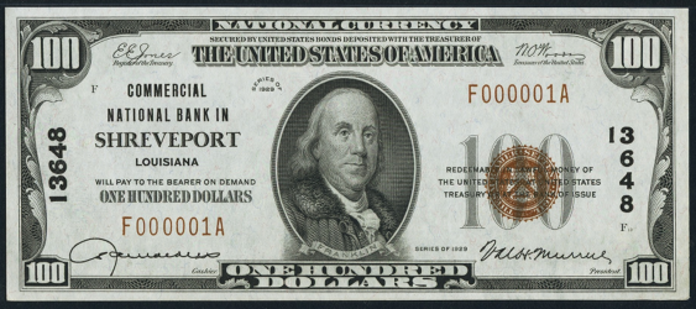One Hundred Dollar Notes › Nationals › 1929 One Hundred Dollar National Bank Notes › New York Charters › 1929 $100 Aurora New York First National Bank
Get Value Now
| Item | Info |
|---|---|
| Series | 1929 |
| Charter | #412 First National Bank of Aurora, New York |
| Year Chartered | 1864, 503 Banks Chartered |
| City Info | Aurora, or Aurora-on-Cayuga, is a village and college town in the town of Ledyard, Cayuga County, New York, United States, on the shore of Cayuga Lake. The village had a population of 724 at the 2010 census. Source: Wikipedia |
| Similar Cities | 20 banks with similar city. First 12 below: 1. Aurora, Illinois - First National Bank 2. Aurora, Indiana - First National Bank 3. Aurora, Illinois - Union National Bank 4. Aurora, Illinois - Second National Bank 5. Aurora, Nebraska - First National Bank 6. Aurora, Illinois - Aurora National Bank 7. Aurora, Indiana - Aurora National Bank 8. Aurora, Illinois - Merchants National Bank 9. Aurora, Missouri - First National Bank 10. Aurora, Illinois - German American National Bank 11. Aurora, Illinois - Old Second National Bank 12. Aurora, Nebraska - Fidelity National Bank |
| Seal Varieties | Small Brown |
| See Also | If your note doesn't match try: 1. 1929 $100 Federal Reserve Bank Note 2. 1928 $100 Federal Reserve Note 3. 1928A $100 Federal Reserve Note 4. 1934 $100 Federal Reserve Note 5. 1934A $100 Federal Reserve Note 6. 1934B $100 Federal Reserve Note |
| Other Info | 1. Value depends on notes known for charter, condition and market demand. |
| Neat Fact | Type 1 issued from May July 1929 - May 1933. Type 2 from May 1933 - 1935 (Friedbergs, 20th Ed. P 191) |
No Obligations Offers and Appraisals
Please submit a good photo or scan. It will be identified and evaluated. Understand there may be subtle differences between the image you see above and your note. Signatures, design, markings and note condition will determine the offer price. Notes in Uncirculated or better condition receive the best offers.
Appraisals can be estimated for wholesale and retail prices. Wholesale is what dealers typically pay. Retail is what a collector might pay. Retail is slightly higher in most cases.
Please visit this page for USA Paper Money Reference. Do not treat this page as a reference guide, it is for appraisal and acquisition purposes only.
